Microsoft Word’s language tools are more than just red or blue squiggly lines. There’s help to choose alternative words, alternate languages, check and improve grammar, hyphenate documents and even test the document for readability.
You may think you know all about the language tools, but Word always has a few extras tucked away to surprise even experts.
Spelling
We all know about the red squiggly line on misspelled words. Right-click to see possible correct spellings.
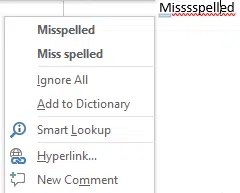
Ignore All – Word will consider that word as correctly spelled in this document. There’s no option to ignore just one instance of a misspelled word.
Add to Dictionary – adds this word to your custom dictionary. It won’t be marked as wrong in any other documents.
Smart Lookup – new in Office 2016. Opens a Bing search for that word in a side-pane.
AutoCorrect
AutoCorrect is Word magically changing common spelling mistakes as you type. It’s different from the speller checker but related.
Things like tpye accomodation youve and many more are loaded into an AutoCorrect list at Options | Proofing | AutoCorrect. When you type something from the ‘Replace’ column, Word will insert the ‘With’ value instead.
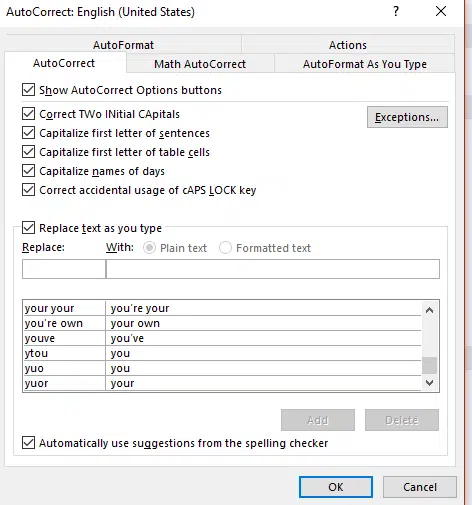
You can add your own common mistakes to this list or use AutoCorrect to save typing by changing a shortcut term into a longer one. (e.g. type IRSf to get Internal Revenue Service )
At the bottom of these options is ‘Automatically use suggestions from the spelling checker’ which ties the spell check to Autocorrect.
Thesaurus
In a paper thesaurus (like the famous Roget’s Thesaurus that I pored over as a kid and still available) you looked up a word to see alternatives or synonyms
Microsoft Word has a thesaurus in some languages. Right-click on a correctly spelled word and choose Synonyms. Here we’re looking for synonyms of ‘thesaurus’:

Click on a synonym to replace the current word.
Or choose ‘Thesaurus…’ to see more in a side-pane. If your computer is connected to the Internet you’ll see extra options.
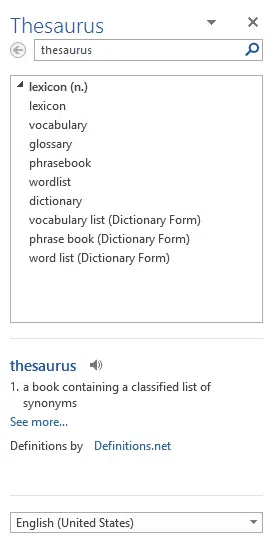
There’s a longer list of synonyms and you can type other words into the search box at the top.
The speaker icon next to the word will play a voice speaking the word.
Click on ‘See More…’ to open a web page about that word. In this case the page includes a great line from Steven Wright, “What’s another word for Thesaurus?“
At the bottom of the pane you can switch languages or variants. For example, switch between US English and ‘real’ English from the Mother Country <g>.

Grammar
The blue squiggly line checks not just for grammar but also common typing mistakes. For example, adding extra spaces between words.

Or missing the comma after ‘For example’ <g>.

Ignore Once – removes the blue squiggly line with no change.
Grammar – opens the Grammar pane to show more options and examples. Like the Spelling pane, there’s a change language option.

The English grammar check in Word isn’t perfect by any means. Just skimming through a document looking for blue squiggles won’t catch everything. Surely this sentence deserved a squiggle or two?

And there are instances where the grammar check is wrong. English is such a messy language that the Microsoft grammar check should be regarded as a minor miracle for what it can do, rather than its shortcomings.
Delay
You may notice a delay in spell and especially grammar checks after typing. In other words, the red or blue squiggles don’t show up as quickly as you might like. That’s deliberate design by Microsoft.
Spell and Grammar checks are done during computer idle time to give more important tasks priority. Unless your machine is particularly busy, that means a delay of a few seconds between typing and checking. If you’re impatient, select the text and press F7 to force a spell and grammar check.
Options
All the options for spelling and grammar are under Options | Proofing:

Word Count and Statistics
On the status bar is a Word Count, click on that to see some more document statistics:
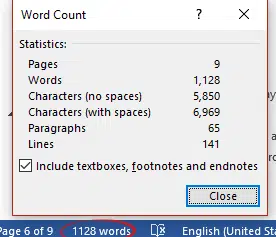
Select some text in the document to see the counts for the selection only. Hold down Ctrl to select separate parts of the document.
Editor
Microsoft Editor is an enhanced grammar and readability tool available in Word 365. Go to Review | Editor or press F7 to start

Readability
See more statistics on the document (or a selection). In modern Word, go to Review | Editor then scroll down to Insights | Document stats.
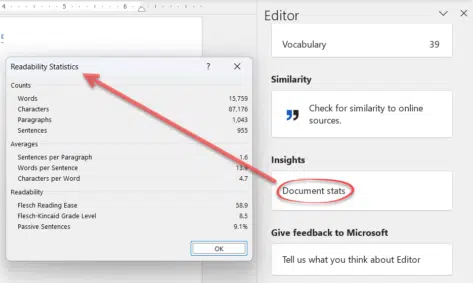
In earlier versions of Word the same details appear by clicking on the Word Count value on the bottom Status Bar or press F7 to see averages and readability statistics:

The Flesh and Flesch-Kincaid scores are a guide only. The scores shown above are for the Gettysburg Address.
Flesch Reading Ease – higher is better / easier to read. The score is based on word and sentence length.
Flesch-Kincaid Grade Level is an approximate school grade level of reading ability. Lower is better/easier to read. They are US school grades which may not directly translate in other countries. Grade 4 is 9-10 year old. Grade 12 is 17-18 years.
Hyphenation
Word can hyphenate words as an option. By default, this option is OFF.
Hyphenation can make the layout of documents smoother by breaking longer words between lines. Here’s an extreme example using a famously long word:

That leaves a large white space gap on the first line. Hyphenation can fix that a reduce the number of lines needed:

How does Word know where to break a long word? That’s where the hyphenation tool comes in. Some languages (not all) include a hyphenation dictionary which tells Word where a word can be hyphenated.
If you want to see where Word may hyphenate a word, choose Layout | Hyphenation | Options | Manual. Word will move to a hyphenated word and show the possible break points.

If there’s a hyphenation dictionary available, you can choose it from Layout | Hyphenation | Automatic.
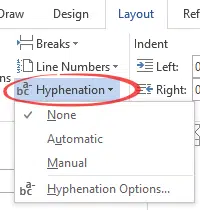
It’s possible to specify your own preferences using the optional hyphen character available from Insert | Symbol | Special Characters or the Ctrl + – shortcut.

The optional hyphen will only appear when necessary to break up a word, otherwise it’s invisible. Handy for long technical terms.
Translation
Word is linked to an online translation tool. Great for us monolinguists to seem smarter than we really are! This feature needs Internet access, which you’re reminded about on first use:

This opens the Research pane where you can choose the language to translate to and from.

Or the Review tab has other options:
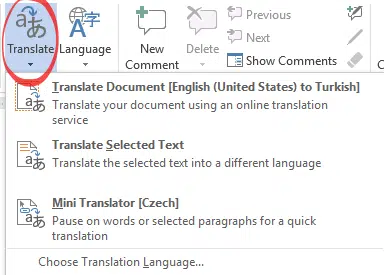
Translate Document will send the entire document for translation. You can select other languages from the pull-down lists at the top of the web page. Mouse over the translated text to see the original.

Translate Selected Text – is much the same but only for the current selection. The result appears in the Research pane and you have to scroll down to see it.

Mini-translator is a multilingual tooltip. Turn this on then hover the mouse over a word to see a translation.
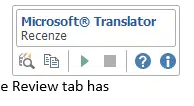
Change the default languages for these options from Review | Translate | Choose Translation Language. As you can see, different languages are possible for the full and mini translator.

Side-by-Side Translation is also possible with a little work.
Languages
Microsoft Office supports many different languages and the major languages have a full set of tools (Spell, Grammar, Thesaurus and Hyphenation). However not all languages have all the tools, in particular Grammar or Hyphenation.